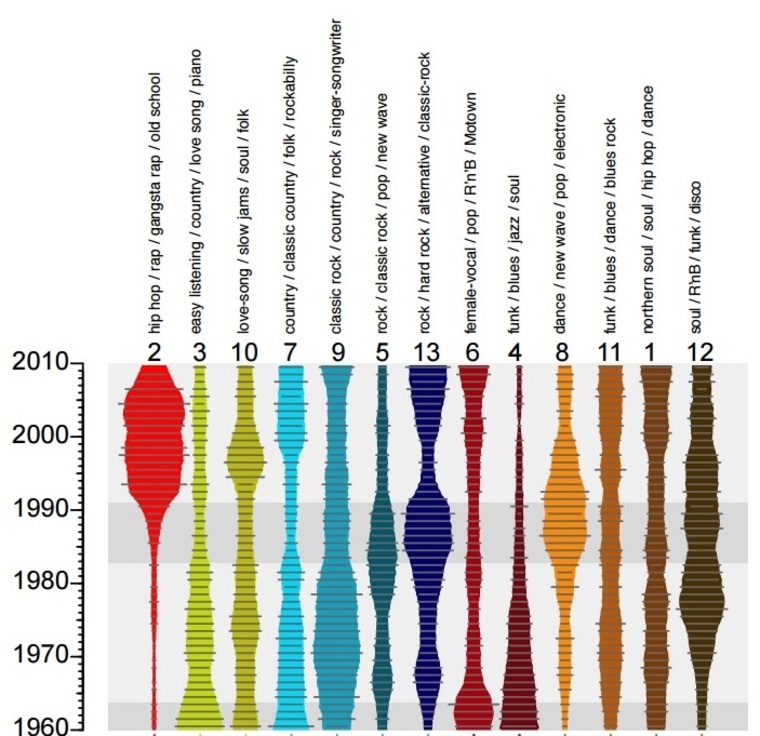Researchers put 17,000 top-selling tunes through the most exhaustive analysis ever attempted for pop music — and found that since the 1960s, musical styles have evolved much like biological organisms. They say the biggest revolution in that evolution came with the rise of hip hop and rap in the 1990s.
The twist in this study is that the conclusions don't come from music critics: Rather, they come from a mathematical analysis of the timbre, tone and harmonic patterns from 30-second audio clips, drawn from the U.S. Billboard Hot 100 songs between 1960 and 2010.
The songs were gathered from the Last.fm database and grouped according to their shared musical characteristics — just as organisms on an evolutionary tree would be grouped by computer software. As a reality check, the researchers looked at how Last.fm's users classified the audio clips, and found that the two methods were in sufficiently close agreement.
Once all that classification was done, the team determined the pace of pop music's evolution.

Read the Research Paper and See the Full-Size Chart
"We show that, although pop music has evolved continuously, it did so with particular rapidity during three stylistic 'revolutions' around 1964, 1983 and 1991," they wrote in a paper published by Royal Society Open Science.
The research team — headed by Mathias Mauch, a computer scientist at Queen Mary University of London —said that the revolution of 1964 was the most complex of the three. That era coincided with the rise of rock (including the Beatles and the Rolling Stones) as well as soul (for example, the Temptations and the Supremes). Disco, hard rock and New Wave rock came into the spotlight in 1983. Hip hop and rap music quickly took center stage in the 1990s — seemingly out of nowhere.
"The rise of rap and related genres appears, then, to be the single most important event that has shaped the musical structure of the American charts in the period that we studied," the researchers wrote.
The trend appears to parallel the pace of biological change — widely known as punctuated equilibrium, in which long stretches of gradual change are interrupted by short periods of rapid change.
So what's behind the pattern in pop music? Mauch and his colleagues refrain from addressing the underlying dynamics in their study, although they note that "the rise of rap in the charts has been credited to the television show 'Yo, MTV Raps!' first broadcast in 1988."
The researchers do suggest that the analytical tools they used on the Billboard Hot 100 could be applied to other examples of cultural evolution — including art and literature as well as the wide spectrum of musical genres. And they say evolutionary theory should provide a means for testing hypotheses about the factors behind pop music's ch-ch-ch-changes.
IN-DEPTH
- Classical Music Purrfect for Calming Cats
- How Listeners Can Spark Musical Evolution
- Sifting Through 50 Years of Beatles Studies
SOCIAL
In addition to Mauch, the authors of "The Evolution of Popular Music: USA 1960-2010" include Robert MacCallum, Mark Levy and Armand Leroi.
